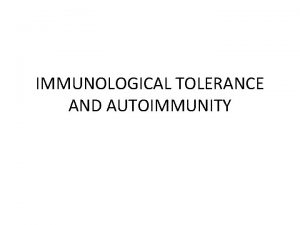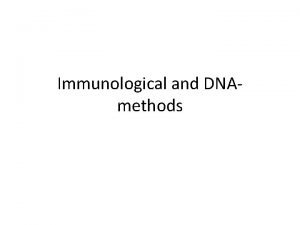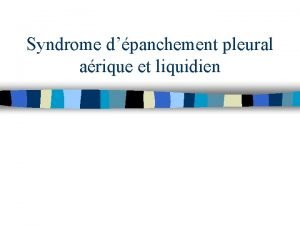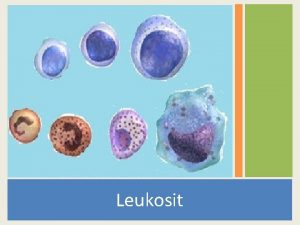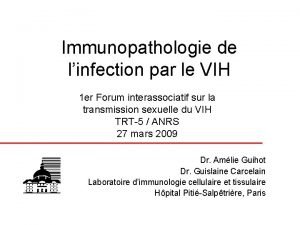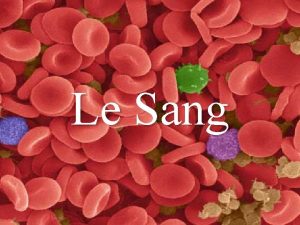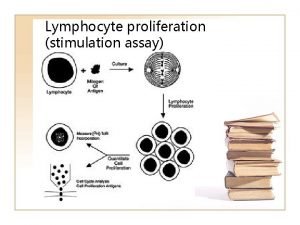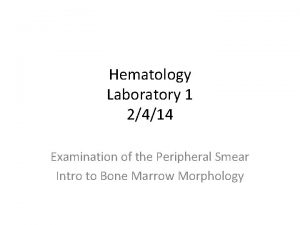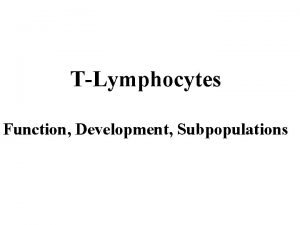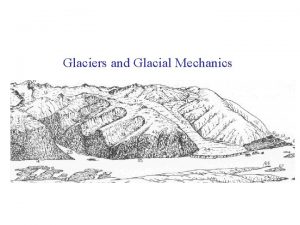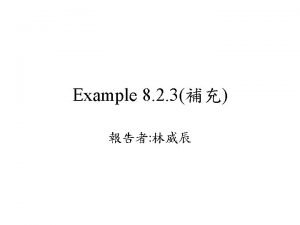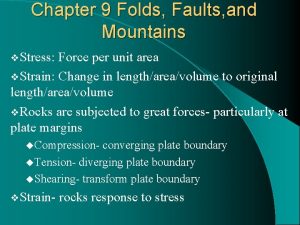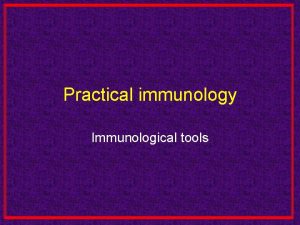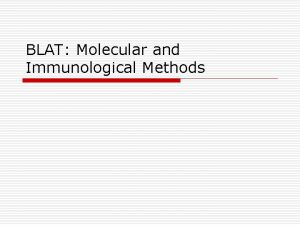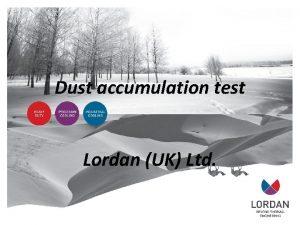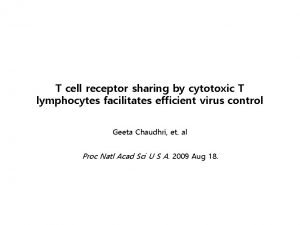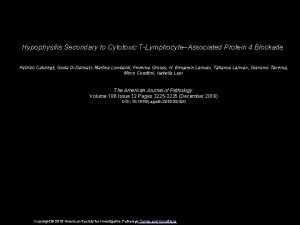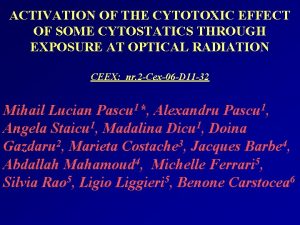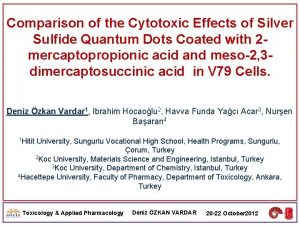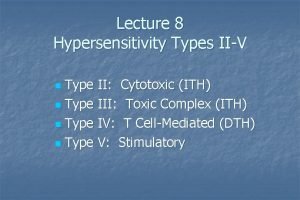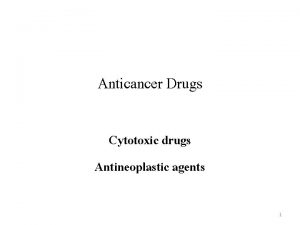Cytotoxic T Lymphocyte Antigen4 Accumulation in the Immunological
























- Slides: 24

Cytotoxic T Lymphocyte Antigen-4 Accumulation in the Immunological Synapse is Regulated by Signal Strength Jackson G. Egen and James P. Allison Howard Hughes Medical Institute Department of Molecular and Cell Biology Cancer Research Laboratory University of California, Berkeley

Co-Stimulatory Molecule Function n Signal 1: TCR + Co-receptor with MHC+peptide ¨ REQUIRE COSTIMULATORY SIGNALS ¨ Signal 2: Co-stimulatory signal from antigen presenting cell Activating co-stimulatory signals promotes synthesis of IL-2 ¨ Required for T cell proliferation and differentiation into effector cells Antigen recognition in absence of co-stimulation results in anergy (inactivation of naïve T cells) Co-stimulatory molecules can also counteract signals provided by the T-cell receptor (inhibitory) ¨ n n n Janeway et al. , 2001 Ligation of T cell receptor and co-receptor does not stimulate naïve T cells to proliferate and differentiate on its own

Co-Stimulatory Molecules: T Cell Antigen Presenting Cell Current Opinion in Immunology 2004, 16: 321– 327

B 7 Molecules: B 7. 1 (CD 80) and B 7. 2 (CD 86) n Homodimeric members of the Immunoglobulin superfamily n Principal costimulatory molecules found on professional antigenpresenting cells n Bind to CD 28 on T cell surface ¨ CD 28 constitutively expressed on both naïve and activated T cells n Upon ligation with CD 28, it leads to: Enhancement of T cell proliferation ¨ Increased production and stability of IL-2 m. RNA ¨ Upregulation of anti-apoptotic genes (ie. Bcl-XL) ¨ Janeway et al. , 2001

Alternative receptor of B 7 molecules: CTLA-4 Janeway et al. , 2001 n Cytotoxic T Lymphocyte Antigen-4 (CD 152) n Similar to CD 28 in amino acid sequence n Binds B 7 molecules with higher avidity than CD 28 (by 2500 fold) n Protein not detectable in naïve T cells, but upregulated upon T cell activation ¨ n Targeted to the endosomal compartment through association of clathrin coated pit adaptor protein (AP-2) and intracellular tail of CTLA-4 (tyr. -based localization motif) Delivers an inhibitory signal to stimulation by APC ¨ Reduces production of IL-2, cyclin D 3, cyclin-dependent kinase 4, 5. : Limits T cell expansion

n Balance between activating signals from CD 28 and inhibitory signals from CTLA-4 determine outcome of a T cell’s interaction with an APC n Temporal and spatial localization of proteins are ways of regulating this balance. Therefore, protein trafficking is thought to be important: Although CD 28 and CTLA-4 are homologues, they have different expression patterns and localization ¨ Trafficking of CD 28 and CTLA-4 occurs by cytoskeletal rearrangements that occur upon T cell stimulation ¨ Upon T cell stimulation, the microtubule organizing centre reorient facing the contact site and protein accumulates at contact site (formation of imm. synapse) ¨ PURPOSE OF EXPERIMENT: To investigate the trafficking characteristics of CD 28 and CTLA-4 to gain insight about how and when these molecules exert their regulatory function on T cell activation ¨

Question: What are the localization patterns of CTLA-4 and CD 28 in activated T cells? Figure 1: Localization of CD 28 and CTLA-4 in Migrating T Cells T cells were stimulated for 5 days with irradiated syngenic splenocytes pulsed with residues 88103 of moth cytochrome c (agonist peptide). Cells were stained with antibodies against tubulin and A) CD 28 or B) CTLA-4. The color overlay images shows tubulin in green, CD 28 or CTLA 4 in red and a nuclear stain in blue.

Results: n n Uropod CD 28 was evenly distributed throughout the plasma membrane of T cell CTLA-4 primarily found around the MTOC and in the uropod CD 28 found at the leading edge of the cell CTLA-4 appeared to be sequestered in intracellular compartment facing away from leading edge Significance: n Localization of proteins may function in determining the kinetics of signaling ¨ Allow CD 28 to quickly interact with B 7 molecules ¨ Delayed CTLA-4 localization due to dependence on TCR-mediated cytoskeletal reorganization Leading edge MTOC

Question: What is the turnover rate of CD 28 and CTLA-4? Figure 2: CTLA-4 Has a Rapid Rate of Protein Turnover Activated 5 C. C 7 TCR transgenic T cells were treated with cycloheximide and/or ammonium chloride. At the indicated time points, cells were permeabilized and stained with antibodies specific for A) transferrin receptor, B) CD 28 or C) CTLA-4 Transferrin and CD 28 expression levels remained relatively constant

Figure 2: CTLA-4 levels ↓ in the absence of new protein translation, accumulation of CTLA-4 when lysosomal degradation is inhibited. Significance: Rapid turnover of CTLA-4 ensures that the level of protein expression is linked to the rate of gene transcription/translation

Antigen-Induced Localization of CD 28 and CTLA-4 to the T Cell-APC Interface Approach: • Mix activated TCR transgenic T cells with B cell pulsed with HB (null) or MCC (agonist) • Immunofluorescence staining Conclusion: Upon agonist stimulation, • MTOC reorganizes • A population of Intracellular CTLA-4 polarizes to a site facing contact site • PKCθ, CD 28 and a population of CTLA-4 accumulate at T cell-APC interface

To better localize CTLA-4 population at the synapse … Approach: Immunoflurescence co-staining with PKCθ and CD 28/CTLA-4 Results: A population of CTLA-4 localizes on T cell surface at immunological synapse independently from its intracellular polarized population

Kinetics of CTLA-4 and CD 28 Localization to T Cell-APC Interface Upon Stimulation • • Retrovirally infected activated TCR transgenic T cell with CD 28 -GFP and CTLA-4 -GFP Live cell fluorescence microscopy: GFP/brightfield time-lapse

Model: Trafficking of CTLA-4 APC Surface CTLA-4 As APC and T cell interact: B 7 CD 28 • CTLA-4 rapidly localize to a site facing contact interface from uropod • intracellular polarized CTLA-4 translocates to surface synapse Intracellular polarized CTLA-4 T cell Non-polarized CTLA-4 §Regulatory check point to control CTLA-4 induced inhibitory signal

Hypothesis: CTLA-4 and CD 28 trafficking to synapse depends on TCR signal strength Step 1: Identify peptides that elicit different T cell response Test MCC and its variants for : IL-2 production T cell-APC conjugates formation Results: Identified 2 agonists and 2 weak agonists for further experiments

More on MCC and its variants Test their ability to reorganize MTOC Conclusion: Both agonist peptides and weak agonist peptides were equally capable of inducing MTOC reorientation

Step 2: test effect of TCR signal strength on surface CTLA-4 expression Approach: • stimulate naïve TCR transgenic T cells with MCC, restimulate with different peptides along with APC • immunofluorescence staining and flow cytometry Must: • use 10 u. M peptide to ensure constant degree of conjugate formation for all • measure total CTLA-4 to ensure constant protein synthesis for all Conclusion: CTLA-4 expression on T cell surface is proportional to the TCR signal strength

Figure 7. TCR signal strength determines translocation of CTLA-4 to T cell-APC interface

Summary of Results CD 28 CTLA- 4 Localization in activated T cells Evenly distributed throughout the plasma membrane Primarily found near the MTOC and in the uropod Turnover rate in activated T cells Relatively slow Rapid Localization upon antigen-specific T cell interaction with APC Detected on entire surface of T cell but most concentrated at center of T cell- APC interface Polarization of intracellular CTLA-4 to contact site + accumulation on the surface of interface Kinetics of localization to T cell- APC interface Almost instantaneous Polarization follows the kinetics of MTOC reorientation Effect of TCR None signal strength on trafficking Stronger TCR signals induce higher CTLA-4 surface expression

Discussion § Intracellular retention of CTLA-4 may serve as a checkpoint to spatially and temporally regulate its function as an inhibitor of T cell activation § Different expression and trafficking patterns between CD 28 and CTLA-4 are potentially important for regulating the balance between the activating and inhibitory signals upon T cell-APC interaction

Dynamic nature of CTLA-4 expression in activated T cells n Intracellular CTLA-4 levels are proportional to its rate of protein synthesis (due to rapid turnover) arresting its gene transcription/translation may quickly downmodulate CTLA-4 -mediated inhibitory signals n T cell-APC interaction (both TCR signaling and B 7 engagement) could alter the turnover of both CD 28 and CTLA-4 another possible regulatory mechanism for controlling protein expression levels

Trafficking of CTLA-4 during T cell-APC interactions n n Translocation of CTLA-4 to the immunological synapse is favored under stronger TCR signals Possible mechanisms of this correlation are: a) stronger signals inducing stronger, more sustained calcium fluxescalcium ionophores are known to upregulate CTLA-4 surface expression by increasing its rate of export to the surface from intracellular compartments b) TCR-mediated protein tyrosine kinase actvity phosphorylating tyrosine in CTLA-4’s AP 2 -binidng site, thereby inhibiting its endocytosis and thus increasing expression of functionally relevant receptors on the surface of immunological synapse n Modulation of composition of immunological synapse by TCR signal strength would provide a means to selectively activate and/or maintain specific T cell signaling pathways

TCR regulation of CTLA-4 -mediated inhibition: from the single cell to the population n n Preferential CTLA-4 -mediated inhibition of high TCR signals attenuation of affinity maturation greater diversity in the T cell response This could: a) improve immune system to respond to mutated or heterologous antigens derived from pathogens b) allow strength of TCR signals to dictate the functional nature of the Ag-specific response (e. g. cytokine expression profile of a particular T cell) c) elaborate a protective T cell response by preventing oligo or even monoclonal responses to a complex set of Ags derived from a pathogen

The Message This study provides the basis for : 1) novel feedback control mechanism where a stimulatory signal regulates the recruitment of an inhibitory receptor to a functionally relevant site on the cell surface 2) previously unrecognized function of CTLA-4 – expanding the diversity of a T cell response by restricting the expansion of T cells receiving stronger stimulation
 Cytotoxic lymphocyte
Cytotoxic lymphocyte Ana hep
Ana hep Immunological methods
Immunological methods Lymphocyte diminué
Lymphocyte diminué Lymphocyte
Lymphocyte Prorubriblast
Prorubriblast Vih
Vih Lymphoide primaire
Lymphoide primaire Lymphocyte proliferation
Lymphocyte proliferation Lymphocyte
Lymphocyte Nucleated rbc
Nucleated rbc Antibody
Antibody Cytotoc
Cytotoc Capital accumulation
Capital accumulation Water balance regulation
Water balance regulation Parking studies and characteristics
Parking studies and characteristics Zone of accumulation
Zone of accumulation Forex accumulation
Forex accumulation What is a period cost on the income statement
What is a period cost on the income statement Cost accumulation and cost assignment
Cost accumulation and cost assignment An atypical accumulation of fluid in the interstitial space
An atypical accumulation of fluid in the interstitial space Accumulation point of a sequence
Accumulation point of a sequence Oil accumulation
Oil accumulation Cost pools
Cost pools Intracellular accumulation
Intracellular accumulation

